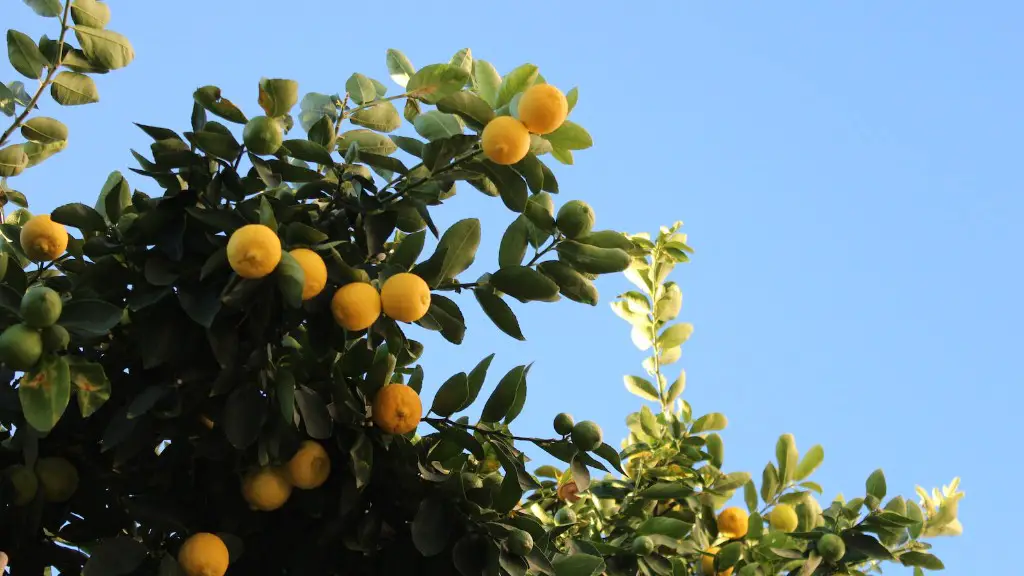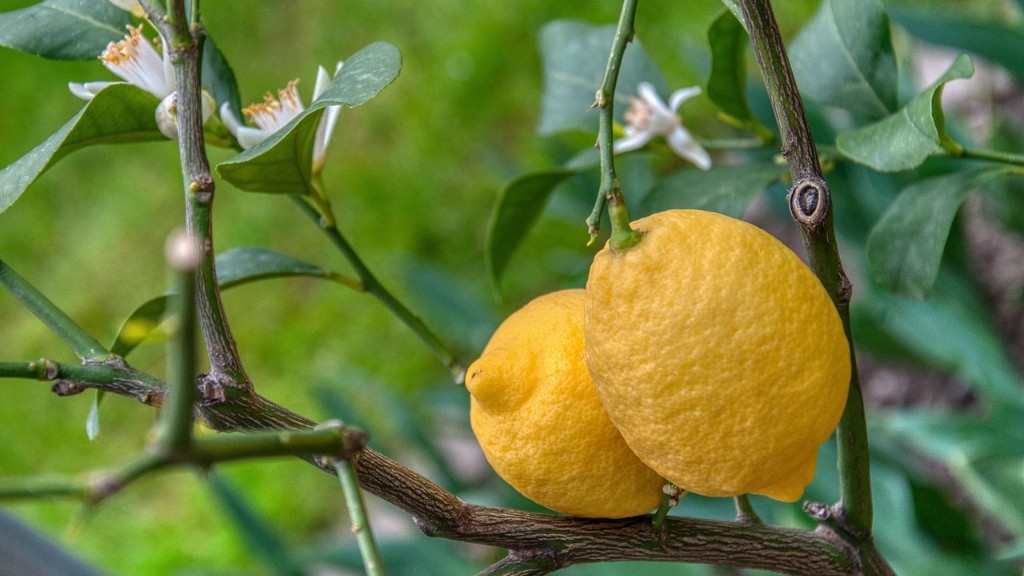Winterizing your lemon tree is a crucial step to maintaining a healthy tree and harvesting a good crop of fruit come summer. If you want to successfully overwinter the lemon tree, you need to follow these specific steps. Firstly, because lemons are a subtropical tree, they require warm temperatures and plenty of water, therefore they need to be irrigated two to three times a week throughout the winter months. Make sure to water at the soil level, not overhead to avoid winter diseases like blights, scabs and rot. Secondly, lemon trees need a sunny location during the growing season, but once winter arrives, it’s best to move it to an area with more shade and protection from wind-driven rain and snow. Thirdly, mulch heavily in late fall, around the base of the tree and remove it in late spring. This will protect the tree’s roots and help retain soil moisture. Fourthly, apply fertilizer once or twice in late fall and again after new growth appears in spring. Use a good, slow-release fertilizer mix or lemon tree food that’s low in nitrogen and high in phosphorous and potassium. Fifthly, prune your lemon tree in late winter or early spring, just before the tree starts to leaf out. Avoid heavy pruning since this can remove potentially productive buds and result in fewer lemons during summer. Sixthly, if your tree is in a container, be sure to repot it in mid to late winter every couple of years to refresh the soil, ensuring that the tree gets the nutrients it needs. Finally, if any sucker shoots appear on the base of the tree, remove them immediately. Suckers can sap energy from the main tree and reduce fruit production.
Shelter for Hardiness
The winter season can be particularly harsh on lemon trees, so providing extra protection during this time is imperative. First, lime and clay rocks or straw should be placed around the base of the tree to insulate the roots, keeping them warm during frosty temperatures. Secondly, wrap the trunk with a good quality horticultural cloth and tie it in place with soft rope or string. Next, make sure that the tree is wrapped snugly with a burlap or fabric blanket, so it doesn’t become vulnerable to cold damage. Last, wrap some sort of additional cloth, like cotton or wool, around the branches to protect against the cold. This will safeguard against the tree becoming brittle or dry due to a lack of moisture.
Winter Care Tips
Caring for lemon trees in winter is just as critical as caring for them in the summer. Firstly, reduce the frequency of irrigation during late fall and winter as the rate of growth slows. Secondly, extra attention should be paid to your tree’s health during this time to help guarantee it will thrive come springtime. For example, check for any signs of fungal infection regularly and inspect for signs of pest infestation. Thirdly, regularly remove any yellowed, diseased or damaged leaves from the tree and dispose of them away from the tree. Lastly, apply a horticultural oil mix to the trunk and branches in late winter, which will help to control overwintering pests like scale insects.
Salting
During winter, salting the soil around the lemon tree can help it battle winter diseases like blights, scabs and leaf spot. Salting ought to be done around mid-winter when the tree is dormant. First, prepare a solution comprised of 2 parts salt to 8 parts warm water and mix until the salts are fully dissolved. Next, slowly pour the solution around the base of the tree to saturate the soil. Finally, then pour in regular water to further hydrate the tree.
Frost Protection
Lemon trees are particularly vulnerable to frost damage in early spring, before buds are ready to open, so it’s best to protect them as soon as temperatures dip below 32°F. Firstly, create a makeshift tent around the entire tree using blankets or tarps. Make sure that the fabric touches the ground to protect against frost on the soil as well. Secondly, you can also hang string lights around the tree to heat it up and keep the ground warm. Or, drape fabric or blankets directly over branches and umbrella-like around the tree, to add additional insulation and protection. Lastly, if a hard freeze is forecasted, sprinkle the tree with lukewarm water and cover it with extra fabric or blankets to keep the tree warm and to add extra insulation.
Keep the Temperature Stable
One of the key strategies to successfully overwinter the lemon tree is to ensure it remains at a relatively stable temperature. Firstly, check the temperatures surrounding your tree and adjust accordingly. Secondly, layer the tree with lightweight fabric between the tree and fragile, cold winter winds. Lastly, if needed, consider using a fan to help circulate the air, preventing temperatures from becoming too cold and allowing for a more balanced temperature.
Avoid Heavy Pruning
It’s important to remember to avoid excessive pruning during the winter as this can potentially reduce fruit production. First, wait until “dormancy” is complete before pruning, usually in late winter or early spring. Then, thin out the branches by cutting off old and diseased branches to keep the tree healthy but only cut off potential produce-bearing buds sparingly. Finally, trim the remaining buds that are no longer producing fruits and remove the tips of the main branches.
Repotting
Lemon trees should be re-potted every couple of years, ideally in mid to late winter when it is dormant. First, move the tree to a larger container, one with more space to accommodate a growing root system. Secondly, mix new potting soil with some of the old soil for a more balanced foundation. Next, remove any dead, woody roots and fill the extra space with fresh potting soil. Lastly, water and fertilize the tree when the repotting has been completed.


